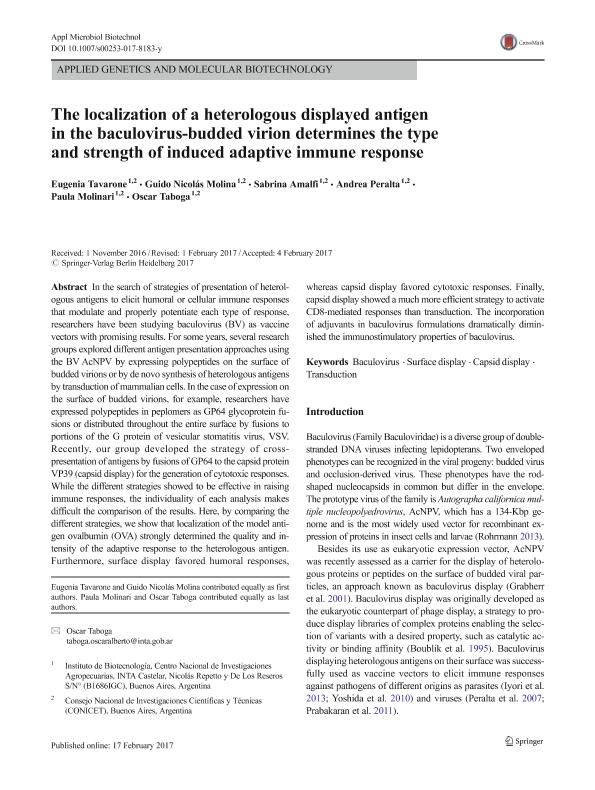Artículo
The localization of a heterologous displayed antigen in the baculovirus-budded virion determines the type and strength of induced adaptive immune response
Tavarone, Maria Eugenia ; Molina, Guido Nicolás
; Molina, Guido Nicolás ; Amalfi, Sabrina
; Amalfi, Sabrina ; Peralta, Andrea Verónica
; Peralta, Andrea Verónica ; Molinari, Maria Paula
; Molinari, Maria Paula ; Taboga, Oscar Alberto
; Taboga, Oscar Alberto
 ; Molina, Guido Nicolás
; Molina, Guido Nicolás ; Amalfi, Sabrina
; Amalfi, Sabrina ; Peralta, Andrea Verónica
; Peralta, Andrea Verónica ; Molinari, Maria Paula
; Molinari, Maria Paula ; Taboga, Oscar Alberto
; Taboga, Oscar Alberto
Fecha de publicación:
05/2017
Editorial:
Springer
Revista:
Applied Microbiology and Biotechnology
ISSN:
0175-7598
e-ISSN:
1432-0614
Idioma:
Inglés
Tipo de recurso:
Artículo publicado
Clasificación temática:
Resumen
In the search of strategies of presentation of heterologous antigens to elicit humoral or cellular immune responses that modulate and properly potentiate each type of response, researchers have been studying baculovirus (BV) as vaccine vectors with promising results. For some years, several research groups explored different antigen presentation approaches using the BV AcNPV by expressing polypeptides on the surface of budded virions or by de novo synthesis of heterologous antigens by transduction of mammalian cells. In the case of expression on the surface of budded virions, for example, researchers have expressed polypeptides in peplomers as GP64 glycoprotein fusions or distributed throughout the entire surface by fusions to portions of the G protein of vesicular stomatitis virus, VSV. Recently, our group developed the strategy of cross-presentation of antigens by fusions of GP64 to the capsid protein VP39 (capsid display) for the generation of cytotoxic responses. While the different strategies showed to be effective in raising immune responses, the individuality of each analysis makes difficult the comparison of the results. Here, by comparing the different strategies, we show that localization of the model antigen ovalbumin (OVA) strongly determined the quality and intensity of the adaptive response to the heterologous antigen. Furthermore, surface display favored humoral responses, whereas capsid display favored cytotoxic responses. Finally, capsid display showed a much more efficient strategy to activate CD8-mediated responses than transduction. The incorporation of adjuvants in baculovirus formulations dramatically diminished the immunostimulatory properties of baculovirus.
Palabras clave:
Baculovirus
,
Capsid Display
,
Surface Display
,
Transduction
Archivos asociados
Licencia
Identificadores
Colecciones
Articulos(SEDE CENTRAL)
Articulos de SEDE CENTRAL
Articulos de SEDE CENTRAL
Citación
Tavarone, Maria Eugenia; Molina, Guido Nicolás; Amalfi, Sabrina; Peralta, Andrea Verónica; Molinari, Maria Paula; et al.; The localization of a heterologous displayed antigen in the baculovirus-budded virion determines the type and strength of induced adaptive immune response; Springer; Applied Microbiology and Biotechnology; 101; 10; 5-2017; 4175-4184
Compartir
Altmétricas



